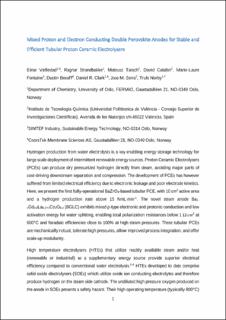| dc.contributor.author | Vøllestad, Einar | |
| dc.contributor.author | Strandbakke, Ragnar | |
| dc.contributor.author | Tarach, Mateusz | |
| dc.contributor.author | Catalán-Martinez, David | |
| dc.contributor.author | Fontaine, Marie-Laure | |
| dc.contributor.author | Beeaff, Dustin | |
| dc.contributor.author | Clark, Daniel Ryan | |
| dc.contributor.author | Serra, José M. | |
| dc.contributor.author | Norby, Truls Eivind | |
| dc.date.accessioned | 2020-11-26T09:38:38Z | |
| dc.date.available | 2020-11-26T09:38:38Z | |
| dc.date.created | 2019-09-21T19:08:12Z | |
| dc.date.issued | 2019 | |
| dc.identifier.citation | Nature Materials. 2019, 18 (7), 752-759. | en_US |
| dc.identifier.issn | 1476-1122 | |
| dc.identifier.uri | https://hdl.handle.net/11250/2689706 | |
| dc.description.abstract | Hydrogen production from water electrolysis is a key enabling energy storage technology for the large-scale deployment of intermittent renewable energy sources. Proton ceramic electrolysers (PCEs) can produce dry pressurized hydrogen directly from steam, avoiding major parts of cost-driving downstream separation and compression. However, the development of PCEs has suffered from limited electrical efficiency due to electronic leakage and poor electrode kinetics. Here, we present the first fully operational BaZrO3-based tubular PCE, with 10 cm2 active area and a hydrogen production rate above 15 Nml min−1. The novel steam anode Ba1−xGd0.8La0.2+xCo2O6−δ exhibits mixed p-type electronic and protonic conduction and low activation energy for water splitting, enabling total polarization resistances below 1 Ω cm2 at 600 °C and Faradaic efficiencies close to 100% at high steam pressures. These tubular PCEs are mechanically robust, tolerate high pressures, allow improved process integration and offer scale-up modularity. | en_US |
| dc.language.iso | eng | en_US |
| dc.publisher | Springer | en_US |
| dc.title | Mixed proton and electron conducting double perovskite anodes for stable and efficient tubular proton ceramic electrolysers | en_US |
| dc.type | Peer reviewed | en_US |
| dc.type | Journal article | en_US |
| dc.description.version | acceptedVersion | en_US |
| dc.source.pagenumber | 752-759 | en_US |
| dc.source.volume | 18 | en_US |
| dc.source.journal | Nature Materials | en_US |
| dc.source.issue | 7 | en_US |
| dc.identifier.doi | 10.1038/s41563-019-0388-2 | |
| dc.identifier.cristin | 1727480 | |
| dc.relation.project | EC/FP7/621244 | en_US |
| dc.relation.project | Norges forskningsråd: 236828 | en_US |
| dc.relation.project | EC/H2020/779486 | en_US |
| cristin.ispublished | true | |
| cristin.fulltext | postprint | |
| cristin.qualitycode | 2 | |
